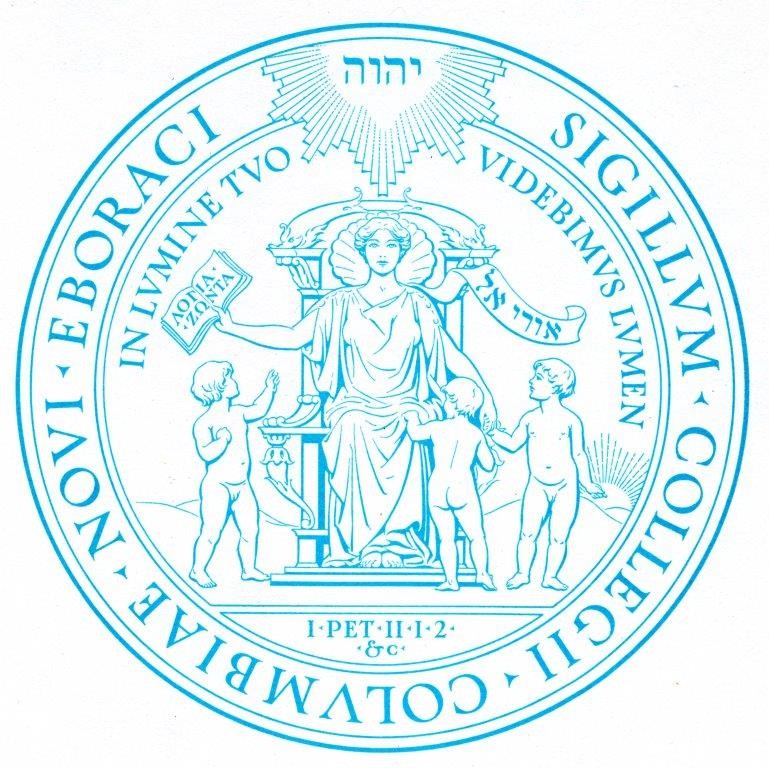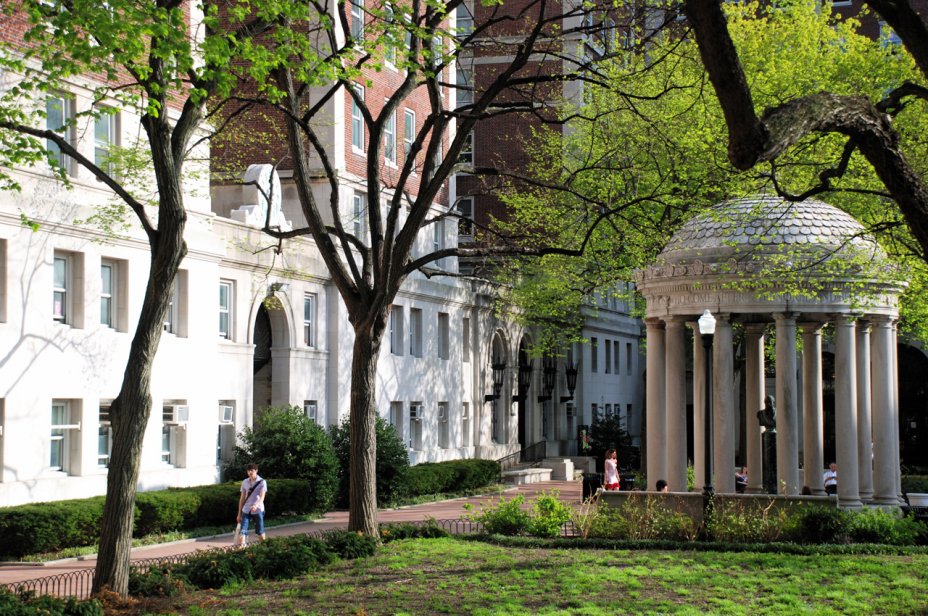Columbia’s Founders:
They Left the Lights On
Reaching to embody the convictions and hopes our founders held for their infant institution, Samuel Johnson, the first President of King’s College, reached into the Bible and drew out a declaration revealing the core of education itself: “In Thy Light Shall We See Light.” (Psalm 36:9)
“In Thy Light Shall We See Light.” (Psalm 36:9)
Columbia’s Founders: They Left the Lights On
This article was published in the 2004 issue of The Beacon.
As Columbia University celebrates its first quarter millennium, the heart and mind of its founders surely seem a quarter-universe away. Reaching for a motto to embody the convictions and hopes our founders held for their infant institution, Samuel Johnson, Doctor of Divinity and first President of King’s College, reached into the heart of the Bible and drew out a declaration revealing the core of education itself, as he saw it:
“In Thy Light Shall We See Light.” (Psalm 36:9)
“In Thy Light Shall We See Light” (Psalm 36:9)
Yes, there should be no mistake: God Himself—not the incandescence of the world’s best intellects—must light this College’s way to truth, knowledge, and academic competence. The College seal commissioned in 1775 enlarges upon the same theme [read about Columbia’s Seal]. After twenty-three decades, it still declares the founders’ purpose—to offer an education illuminated by the Bible, the living word of the living God.
In 2004, these tokens of founding purpose find employment chiefly as relics of Columbia’s beginnings—testifying that we were not born yesterday. The world our founders knew has spawned one they could scarcely recognize, and their convictions about education have given way to inclusion of more of the world’s ideas and cultures than they could have imagined. Few souls here openly search for a guiding light much beyond the kaleidoscope of our assembled intellects, roots, and aspiration.

But it is conceivable that as we have put off our founders’ wardrobe of 18th -century ideas, we also have cast off something irreplaceable at the heart of their vision? How would we even know?
Our accustomed progressive outlook tells us that these 250 years have brought some of the greatest advances in human history. Who would argue otherwise? If nothing else, the triple tides of exploding knowledge; instant, vivid communication; and swift travel anywhere have re-made the world. Great universities have held front-row seats at this multi-ring spectacle. Sometimes, they have stood at revolution’s epicenter.
But honesty must confess that in spite of our hopes and excitement, our most vexing problems remain unsolved and—it can seem—untouched. Lies and death cruise the same superhighways as truth and hope of a better life. Mocking our humanist optimism, the twentieth century brought fresh tides of brutality magnified to stark enormity, as science armed the whims of still-evil men with unimagined power.
What role does quarter-millennial Columbia play in all this? We question everything; what answers do we offer? Do we contribute to solutions? Or do we embody many of the problems? Does the modern university offer society some hope, or has it drifted towards irrelevance? What capacity do we have to make a difference? More questions beg to be asked:
Among the beliefs and identities we have grown careful to validate and protect, have we found anything that merits our shared hopes? Is there something for us to be guided by that will not, in the end, dash them? Could the guiding Light of Columbia’s founders be the light we need now?
At its quarter-millennial, we believe that our alma mater would do well to look to the landmarks its founders left. With clear conviction, Samuel Johnson declared:
“The chief thing that is aimed at in this college is to teach and engage the [students] to know God in Jesus Christ, and to love and serve Him in all sobriety, godliness, and righteousness of life, with a perfect heart, and a willing mind; and to train them up in all virtuous habits and all such useful knowledge as may render them creditable to their families and friends, ornaments to their country, and useful to the public weal in their generations.”
John Howard Van Amringe, Dean of Columbia College, 1896-1910, voiced similar convictions, though perhaps less clearly defined. His words are, literally, carved in stone on two benches facing his memorial in VanAm Quad, on the South Campus:
“Religion and learning are justified of their children [reference to Luke 7:35]. To extend and intensify their elevating and twice blessed power, this college and university avowedly exist. Be brave, faithful and true. By precept and example, stand always and everywhere for rectitude of conduct and righteousness of life.”
Columbians attending next spring’s Commencement will not expect to be treated to exhortations like these. But though the tribe that speaks the language of Johnson and Van Amringe long ago vacated Columbia’s offices, it has not disappeared. These lights of the past would recognize some kin at Columbia even now.

We would like to speak as boldly as they did: Jesus Christ is still the Light of the World. He has been the Light of generations before us, of men and women who proved to themselves that He is still the best, the only, hope for an individual or for society. Not 250 years, nor 250 centuries, have brought a student, or the world, anything to match Him.
The founders’ 18th century convictions, and our 21st century affirmations, suggest a certain urgency. What could be urgent about ideas hundreds—no, thousands—of years old? The Bible, Jesus Himself, and God’s Spirit say expressly that what our future holds is neither a long-awaited arrival of enlightenment and peace, nor a mere extrapolation of the past. Before real rest from human history’s madness, they testify that we will face the most trying of times—times, conditions, and events to confound the most superbly equipped minds any university harbors.
To brave the white waters of the coming rapids alone—without Christ—is to plunge into them headlong and blind. A wrenching passage will separate the unshakable—a life built on Jesus, the Rock—from all else, which must be shaken to its core. Our degrees, wits, skills, connections, and portfolios—as useful and as desirable as they are—will not save one of us in the narrows ahead. It is, indeed, later than most of us imagine.
These alarms may sound vaguely extreme—like a Homeland Security alert without actionable specifics. But they are the ancient warnings that the Bible declares in concert and constancy from the Torah, Psalms, Proverbs, Prophets, Gospels, and apostles. A straightforward reading of the Bible reveals how very specific its warnings are—highly actionable and altogether effective. It is impossible to prepare for what lies ahead, except through personal acquaintance with the God and Savior whom Samuel Johnson called the Light who must light this University’s way.
Few acts have become as marginalized in the atmosphere of a 21st century university campus as a student’s investment of personal, radical faith in Jesus Christ. No—those who draw their lives from Him are not out of step; they are only ahead of their time. With everyone at Columbia who has come to love Jesus, we heartily extend you His invitation: acquaint yourself with Him, and discover for yourself why the men responsible for Columbia’s beginnings believed that we must make Him our Light.
Jaan E. Vaino, Columbia U., ’83
Seal
IN THY LIGHT… COLUMBIA’S SEAL
The description of the seal of King’s College at New York in America.
(The original description written by the first president, Rev. Samuel Johnson D.D., when the seal was first ordered by the governors of King’s College, 2 June 1775)
The college is represented by a lady sitting in a throne or chair of slate, with several children at her knees, to represent the pupils, with 1 Peter II, 1,2 &c. under them expressing the temper with which they should apply themselves to seek for true wisdom. The words are: “Wherefore laying aside all malice and guile and hypocrisies and envies and all evil speakings, as newborn babes, desire the sincere milk of the Word, that ye may grow thereby.” [v.7, also cited, reads: “Unto you therefore which believe he is precious: but unto them which be disobedient, the stone which the builders disallowed, the same is made the head of the corner…”]
One of them she takes by the hand with her left hand, expressing her benevolent design of conducting them to true Wisdom and virtue, to which purpose she holds open to them a Book in her right hand, in which is Greek letters LOGIA ZONTA, the living or Lively Oracles, which is the epithet that St. Stephen gives to the Holy Scriptures, Acts VII, 38.
Over her head is the sacred name JEHOVAH in a triangular glory, the lower point terminating at her head, and her motto round over it, IN LUMINE TUO VIDEBIMUS LUMEN, In Thy Light shall we see light, Psalm XXXVI, 9. Out of her mouth over her left shoulder goes a label with these words in Hebrew letters AURI AL, God is my light, alluding to Psalm XXVII, 1, “The Lord is my light and my salvation,” expressing her acknowledgement of God, the Father of Lights [James 1:17] as the fountain of all that light, both natural and revealed, with which she proposes to enlighten or instruct her children, or pupils, whereof the sun rising under the label is the emblem or hieroglyphic, alluding to that expression in Malachi IV, 2, “The Sun of Righteousness shall arise with healing in his wings.”
On the edge around are engraved in capitals SIGLIUM COLLEGII COLUMBIAE NOVI EBORACI, Seal of Columbia College, New York.
